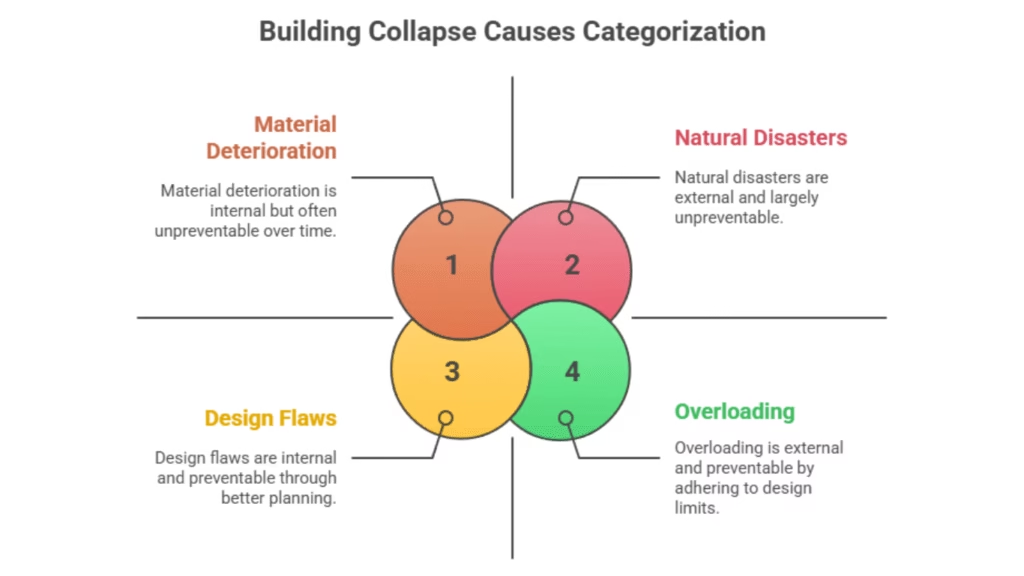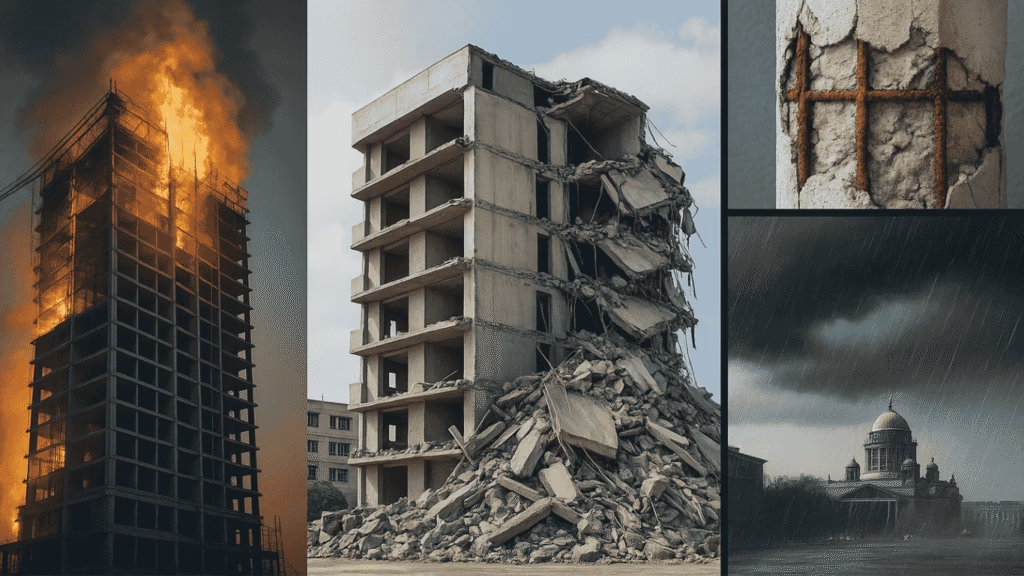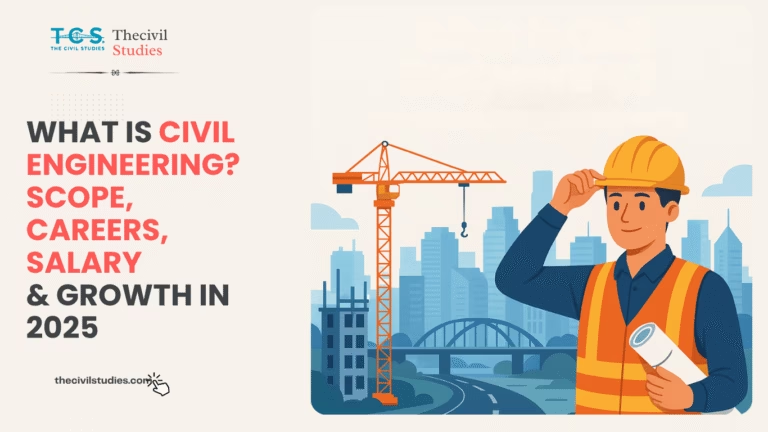Introduction: Why Do Strong Buildings Suddenly Collapse?
On June 24, 2021, a 12-story condominium in Surfside, Florida, near Miami, collapsed suddenly, claiming nearly 100 lives. It was one of the deadliest structural failures in U.S. history. Yet, it wasn’t the first — nor is it likely to be the last. Around the world, buildings that are meant to stand for decades sometimes fall apart in seconds.
From South Korea’s Sampoong Department Store collapse in 1995 to the Rana Plaza disaster in Bangladesh, structural failures have led to massive loss of life, property, and trust. Despite modern technology, why do buildings collapse so catastrophically? Are there signs we miss before disaster strikes? And what can modern engineering do to prevent future tragedies?

Common Causes of Building Collapse
1. Overloading Beyond Design Capacity
Buildings are designed with specific load limits—known as design loads—that include structural weight, occupancy loads, and environmental stresses. When these limits are exceeded, load-bearing elements like beams or columns may fail.
A tragic example is the 2013 Rana Plaza factory collapse in Dhaka, Bangladesh. The building was originally designed for commercial use, but multiple garment factories operated inside. The building couldn’t support the added weight, and it collapsed, killing at least 1,132 people.
Even high-quality materials can deteriorate over time. When load-bearing components like beams and columns weaken, overloading becomes an invisible threat.
2. Material Deterioration and Corrosion Over Time
Materials like steel and concrete deteriorate due to environmental exposure, chemical reactions, or poor maintenance. Reinforced concrete structures are especially vulnerable when steel reinforcement rusts, expands, and cracks the surrounding concrete.
Steel used in concrete can rust and expand up to six or seven times its original volume. This creates internal pressure, leading to cracks in the concrete. Once cracks form, moisture seeps in, accelerating decay. Over time, this silently compromises the entire structural integrity.
3. Foundation Failure and Uneven Ground Settling
When buildings are constructed on soft soil, reclaimed land, or marshland, the ground can shift or compress over time, causing the foundation to settle unevenly.
When foundations settle unevenly or rapidly, the building can collapse from the base upward — creating what’s known as a “pancake effect” where each upper floor crashes down on the one below. This domino collapse is especially common in high-rise buildings with compromised foundations.
Case Insight: Many urban buildings collapse not due to poor construction but because of poor geotechnical site selection and inadequate soil investigation.
4. Design Flaws and Lack of Structural Redundancy
Not all buildings are designed with adequate safety margins or alternative load paths. In some cases, a single point of failure can bring down the entire structure if load redistribution is not built into the design.
Poor structural planning, miscalculations, or missing safety factors can lead to catastrophic failure. If the structure lacks proper load redistribution paths, the failure of a single column or beam can trigger a total collapse.
Real-World Lesson: The Sampoong Department Store in Seoul collapsed after modifications were made without structural analysis, removing support columns that were critical to the building’s integrity.
5. Natural Disasters and Their Impact on Buildings
Earthquakes, hurricanes, fires, and floods are significant external threats to buildings. While some disasters are unpredictable, modern engineering has developed ways to mitigate their impact through seismic design and disaster-resilient materials.
During earthquakes, for instance, seismic waves shake a building’s foundation. If that energy isn’t absorbed or redirected, it causes structural damage from the ground up.
But engineers now use a variety of earthquake-resistant systems, such as:
- Seismic Dampers – Absorb and dissipate vibration energy
- Base Isolation – Decouples the building from ground motion
- Seismic Invisibility Cloaks – Use concentric rings underground to scatter seismic waves

How Modern Engineering Prevents Building Failures
The good news? Modern engineering is evolving fast.
Shock Absorbers and Seismic Dampers
These act like car shock absorbers but for skyscrapers — absorbing earthquake energy to protect structural elements.
Base Isolation Systems
These involve mounting buildings on flexible bearings or sliders that move independently from the ground, shielding the structure from shaking.
Seismic Cloaking
Using strategically placed plastic and concrete rings around the foundation, this technique interferes with incoming seismic waves — reducing their destructive force.
Advanced Materials: Metal Foams & Self-Healing Concrete
Metal foams, used in joints and connectors, absorb high-impact energy. Meanwhile, self-healing concrete contains special bacteria or polymers that activate when cracks appear, automatically sealing the damage and restoring strength.
Learning from Real Collapses: Prevention Over Reaction
Each tragic building collapse has taught engineers vital lessons:
- Don’t cut corners in material quality or design.
- Ensure independent structural audits and building code compliance.
- Conduct regular inspections and maintenance.
- Prioritize disaster-resilient design, especially in high-risk zones.
The collapse of buildings like Champlain Towers in Florida or the Sampoong Department Store in South Korea serve as stark reminders of how small failures can cascade into large-scale disasters.
These events also teach us that proactive maintenance, proper design review, building audits, and adherence to codes are not optional — they’re essential for safety.
Conclusion: Building for a Safer Future
While no building is truly indestructible, modern technology and sound engineering practices offer hope. From better materials to smarter designs, we now have tools to prevent most collapses — if we choose to use them.
The key lies in proactive inspections, enforcement of safety codes, and the willingness to invest in resilience — before it’s too late.
Frequently Asked Questions (FAQ)
What are the main causes of building collapse?
The main causes of building collapse include structural overloading, design flaws, foundation failure, material deterioration (like rusted reinforcement), and natural disasters such as earthquakes or hurricanes. Poor construction practices, illegal modifications, and lack of maintenance can also contribute significantly.
How can overloading lead to building failure?
Overloading occurs when a building supports more weight than it was originally designed for—whether through unauthorized floor additions, heavy machinery, or excessive occupancy. This can cause structural elements to crack, bend, or collapse under stress.
What are some warning signs of a potential building collapse?
Common early warning signs include visible cracks in walls or columns, sagging floors, leaking roofs, rust stains, exposed rebar, creaking noises, or doors/windows not closing properly. If these issues are ignored, they can lead to sudden structural failure.
Which was the deadliest building collapse in recent history?
One of the deadliest recent building collapses was the Rana Plaza disaster in Bangladesh (2013), which killed over 1,100 people. The building was illegally modified and overloaded beyond its design capacity, making it highly unstable.
Can natural disasters like earthquakes cause buildings to collapse?
Yes. Earthquakes generate ground motion that transfers destructive energy into buildings. Without proper seismic design elements like shock absorbers or base isolation, buildings can crack, tilt, or collapse completely during an earthquake.
How can engineers prevent buildings from collapsing?
Engineers use advanced design techniques such as seismic dampers, base isolation systems, self-healing concrete, metal foams, and smart sensors. Regular structural inspections and adherence to updated building codes also play a crucial role in prevention.
What role does poor construction play in building collapses?
Poor construction—like using substandard materials, lack of supervision, or ignoring design codes—significantly increases the risk of collapse. Many past disasters have been linked to shortcuts during construction or unauthorized structural changes.
Are modern buildings safer from collapse?
Modern buildings, when designed and built to code, are significantly safer thanks to innovations in materials, design simulations, disaster-resistant technologies, and quality control. However, safety still depends on proper execution and ongoing maintenance.
What should you do if you notice structural damage in a building?
Immediately report visible damage to a licensed structural engineer or local building authority. Evacuate if there are serious signs like deep cracks, tilting, or loud creaks. Never ignore potential warning signs of structural instability.





